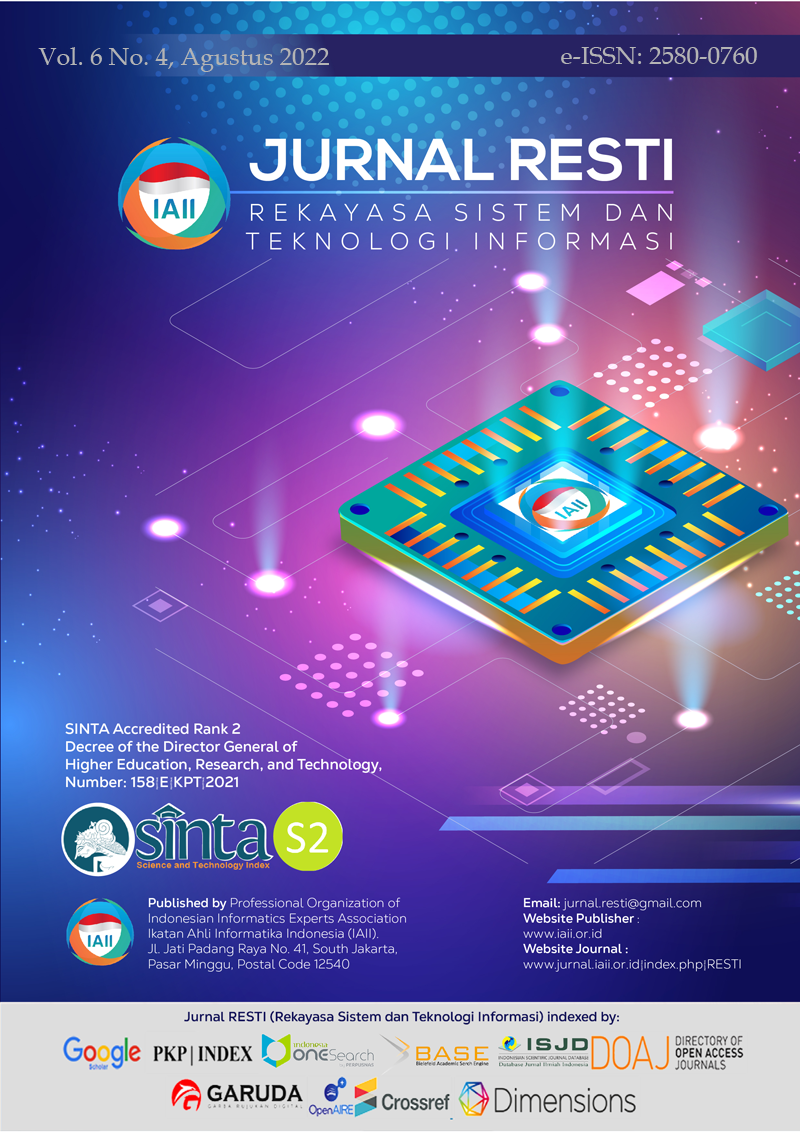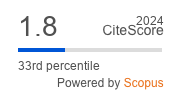Time Series Temperature Forecasting by using ConvLSTM Approach, Case Study in Jakarta
Abstract
Climate change has occurred in several countries, especially in tropical countries such as Indonesia. It causes extreme temperature changes in several Indonesian areas, especially Jakarta, one of the world's most populated cities. The population of Jakarta causes the activities carried out by residents to be disturbed by extreme temperature changes. In addition, drastic temperature changes also affect the energy consumption used by residents. Therefore, it is necessary to predict temperature to determine future temperature conditions so that residents can plan their activities. Temperature forecast can be done in several ways, one of which uses a machine learning approach. This research uses a deep learning model called the Convolutional Long Short-Term Memory (ConvLSTM). Moreover, we also compare the model with Multi-Layer Perceptron (MLP), and Long Short-Term Memory (LSTM). We use temperature data taken from the ERA-5 period years 2018 to 2020 located in Kemayoran, Jakarta, Indonesia. This research aims to investigate the accuracy of short-term temperature forecasting by using these three models. The model is built to predict short-term temperatures for 1, 3, and 7 days ahead. The performance of the three methods is measured by calculating the Root Mean Square Error (RMSE), Mean Square Error (MAE), and Coefficient Correlation (CC). The result shows that the LSTM performs better than the other methods to forecast 1, 3, and 7 days, i.e., with the lowest RMSE, MAE, and higher CC.
Downloads
References
C. Johnstone and E. D. Sulungu, “Application of neural network in prediction of temperature: a review,” Neural Computing and Applications, vol. 33, no. 18. Springer Science and Business Media Deutschland GmbH, pp. 11487–11498, Sep. 01, 2021. doi: 10.1007/s00521-020-05582-3.
E. Fahimi Nezhad, G. Fallah Ghalhari, and F. Bayatani, “Forecasting Maximum Seasonal Temperature Using Artificial Neural Networks ‘Tehran Case Study,’” Asia-Pacific Journal of Atmospheric Sciences, vol. 55, no. 2, pp. 145–153, May 2019, doi: 10.1007/s13143-018-0051-x.
M. A. Lokoshchenko and N. A. Nikolaeva, “Dependence of energy consumption on air temperature in Moscow,” Russian Meteorology and Hydrology, vol. 42, no. 12, pp. 783–791, Dec. 2017, doi: 10.3103/S1068373917120068.
B. Spencer, O. Alfandi, and F. Al-Obeidat, “A Refinement of Lasso Regression Applied to Temperature Forecasting,” in Procedia Computer Science, 2018, vol. 130, pp. 728–735. doi: 10.1016/j.procs.2018.04.127.
Y. Hirano, K. Gomi, S. Nakamura, Y. Yoshida, D. Narumi, and T. Fujita, “Analysis of the impact of regional temperature pattern on the energy consumption in the commercial sector in Japan,” Energy and Buildings, vol. 149, pp. 160–170, Aug. 2017, doi: 10.1016/j.enbuild.2017.05.054.
B. B. Karthika S, “MODELING OF AIR TEMPERATURE USING HYBRID WAVELET TRANSFORM-ANFIS-SUPPORT VECTOR MACHINE COMPUTING TECHNIQUES,” 2016.
Z. Zhang, Y. Dong, and Y. Yuan, “Temperature Forecasting via Convolutional Recurrent Neural Networks Based on Time-Series Data,” Complexity, vol. 2020, 2020, doi: 10.1155/2020/3536572.
J. Cifuentes, G. Marulanda, A. Bello, and J. Reneses, “Air temperature forecasting using machine learning techniques: A review,” Energies, vol. 13, no. 6. MDPI AG, Aug. 01, 2020. doi: 10.3390/en13164215.
E. Abrahamsen, O. M. Brastein, and B. Lie, “Machine Learning in Python for Weather Forecast based on Freely Available Weather Data,” in Proceedings of The 59th Conference on imulation and Modelling (SIMS 59), 26-28 September 2018, Oslo Metropolitan University, Norway, Nov. 2018, vol. 153, pp. 169–176. doi: 10.3384/ecp18153169.
I. Park, H. S. Kim, J. Lee, J. H. Kim, C. H. Song, and H. K. Kim, “Temperature prediction using the missing data refinement model based on a long short-term memory neural network,” Atmosphere (Basel), vol. 10, no. 11, Nov. 2019, doi: 10.3390/atmos10110718.
S. Salcedo-Sanz, R. C. Deo, L. Carro-Calvo, and B. Saavedra-Moreno, “Monthly prediction of air temperature in Australia and New Zealand with machine learning algorithms,” Theoretical and Applied Climatology, vol. 125, no. 1–2, pp. 13–25, Jul. 2016, doi: 10.1007/s00704-015-1480-4.
D. Kreuzer, M. Munz, and S. Schlüter, “Short-term temperature forecasts using a convolutional neural network — An application to different weather stations in Germany,” Machine Learning with Applications, vol. 2, p. 100007, Dec. 2020, doi: 10.1016/j.mlwa.2020.100007.
A. N. Ahmed, T. van Lam, N. D. Hung, N. van Thieu, O. Kisi, and A. El-Shafie, “A comprehensive comparison of recent developed meta-heuristic algorithms for streamflow time series forecasting problem,” Applied Soft Computing, vol. 105, Jul. 2021, doi: 10.1016/j.asoc.2021.107282.
A. Olawoyin and Y. Chen, “Predicting the future with artificial neural network,” in Procedia Computer Science, 2018, vol. 140, pp. 383–392. doi: 10.1016/j.procs.2018.10.300.
T. T. K. Tran, S. M. Bateni, S. J. Ki, and H. Vosoughifar, “A review of neural networks for air temperature forecasting,” Water (Switzerland), vol. 13, no. 9. MDPI AG, May 01, 2021. doi: 10.3390/w13091294.
A. Sagheer and M. Kotb, “Time series forecasting of petroleum production using deep LSTM recurrent networks,” Neurocomputing, vol. 323, pp. 203–213, Jan. 2019, doi: 10.1016/j.neucom.2018.09.082.
T. T. Kieu Tran, T. Lee, J. Y. Shin, J. S. Kim, and M. Kamruzzaman, “Deep learning-based maximum temperature forecasting assisted with meta-learning for hyperparameter optimization,” Atmosphere (Basel), vol. 11, no. 5, May 2020, doi: 10.3390/ATMOS11050487.
M. Rahman, D. Islam, R. J. Mukti, and I. Saha, “A deep learning approach based on convolutional LSTM for detecting diabetes,” Computational Biology and Chemistry, vol. 88, Oct. 2020, doi: 10.1016/j.compbiolchem.2020.107329.
S. W. Lee and H. Y. Kim, “Stock market forecasting with super-high dimensional time-series data using ConvLSTM, trend sampling, and specialized data augmentation,” Expert Systems with Applications, vol. 161, Dec. 2020, doi: 10.1016/j.eswa.2020.113704.
G. Zhu, L. Zhang, P. Shen, and J. Song, “Multimodal Gesture Recognition Using 3-D Convolution and Convolutional LSTM,” IEEE Access, vol. 5, pp. 4517–4524, 2017, doi: 10.1109/ACCESS.2017.2684186.
X. Shi et al., “Convolutional LSTM Network: A Machine Learning Approach for Precipitation Nowcasting.”
Copyright (c) 2022 Jurnal RESTI (Rekayasa Sistem dan Teknologi Informasi)

This work is licensed under a Creative Commons Attribution 4.0 International License.
Copyright in each article belongs to the author
- The author acknowledges that the RESTI Journal (System Engineering and Information Technology) is the first publisher to publish with a license Creative Commons Attribution 4.0 International License.
- Authors can enter writing separately, arrange the non-exclusive distribution of manuscripts that have been published in this journal into other versions (eg sent to the author's institutional repository, publication in a book, etc.), by acknowledging that the manuscript has been published for the first time in the RESTI (Rekayasa Sistem dan Teknologi Informasi) journal ;








